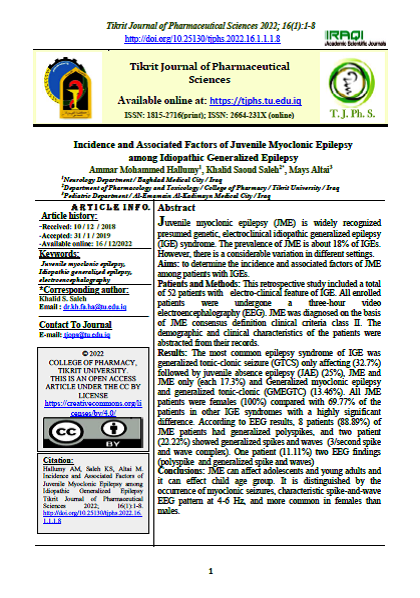Incidence and Associated Factors of Juvenile Myoclonic Epilepsy among Idiopathic Generalized Epilepsy
DOI:
https://doi.org/10.25130/tjphs.2022.16.1.1.1.8Keywords:
Juvenile myoclonic epilepsy, Idiopathic generalized epilepsy, electroencephalographyAbstract
Juvenile myoclonic epilepsy (JME) is widely recognized presumed genetic, electroclinical idiopathic generalized epilepsy (IGE) syndrome. The prevalence of JME is about 18% of IGEs. However, there is a considerable variation in different settings.
Aims: to determine the incidence and associated factors of JME among patients with IGEs.
Patients and Methods: This retrospective study included a total of 52 patients with electro-clinical feature of IGE. All enrolled patients were undergone a three-hour video electroencephalography (EEG). JME was diagnosed on the basis of JME consensus definition clinical criteria class II. The demographic and clinical characteristics of the patients were abstracted from their records.
Results: The most common epilepsy syndrome of IGE was generalized tonic-clonic seizure (GTCS) only affecting (32.7%) followed by juvenile absence epilepsy (JAE) (25%), JME and JME only (each 17.3%) and Generalized myoclonic epilepsy and generalized tonic-clonic (GMEGTC) (13.46%). All JME patients were females (100%) compared with 69.77% of the patients in other IGE syndromes with a highly significant difference. According to EEG results, 8 patients (88.89%) of JME patients had generalized polyspikes, and two patient (22.22%) showed generalized spikes and waves (3/second spike and wave complex). One patient (11.11%) two EEG findings (polyspike and generalized spike and waves)
Conclusions: JME can affect adolescents and young adults and it can effect child age group. It is distinguished by the occurrence of myoclonic seizures, characteristic spike-and-wave EEG pattern at 4-6 Hz, and more common in females than males.

Downloads
Published
How to Cite
Issue
Section
License
Copyright (c) 2022 Tikrit Journal of Pharmaceutical Sciences

This work is licensed under a Creative Commons Attribution 4.0 International License.
This is an open-access journal, and all journal content is available for readers free of charge immediately upon publication.





